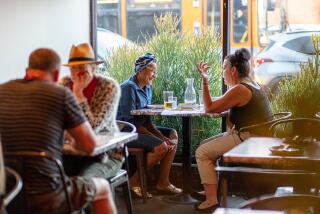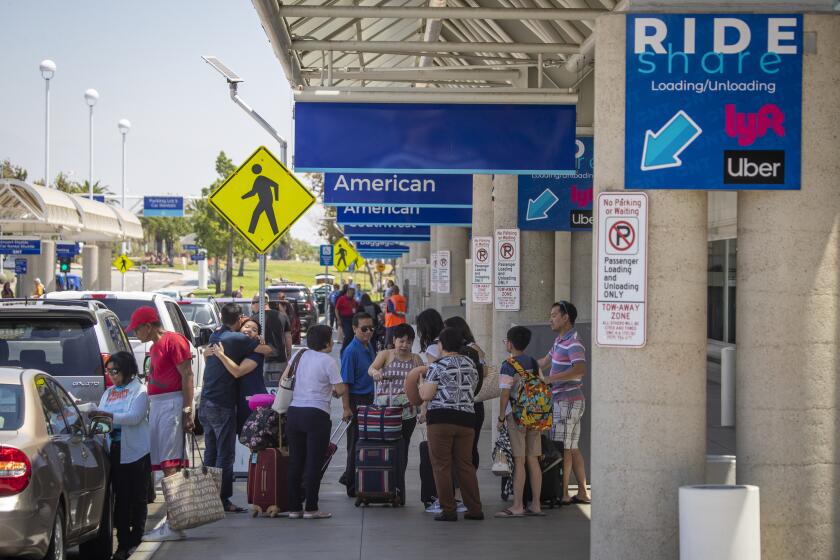CITY SMART: How to thrive in the urban environment of Southern California. : Four-Level Interchange Is a Four-Letter Word to Some and a Marvel to Others
They called it an engineering marvel when it opened four decades ago in Downtown Los Angeles.
But today, commuters who slog through the world’s first four-level interchange are more likely to think four-letter .
The Rodney Dangerfield interchange--of the Harbor, Hollywood and Pasadena freeways--has been a Los Angeles landmark since the first traffic report was broadcast.
A “mad motorist’s dream” was how the Saturday Evening Post described the towering interchange after it was fully opened in 1953 to 32 lanes of traffic flowing simultaneously in eight directions.
Today, newer and taller interchanges draw the oohs and ahs-- such as the graceful tentacles of concrete that loop between the new Century Freeway and the Harbor and San Diego freeways.
And what’s more, they’re five levels.
The tangled web of 20 long-legged bridges that connect the Century and Harbor freeways stands 12 stories high and provides a sweeping view of the city.
“You don’t have to be an aficionado of concrete to appreciate it,” said James L. Moore II, co-director of the USC Center of Advanced Transportation Technologies. “I have to work hard to keep my mind on the road every time I drive underneath it because I’m looking at the structure.”
Everyone seems to have their own favorite interchange.
Urban critic Reyner Banham, author of “Los Angeles: The Architecture of Four Ecologies,” admired the “wide-swinging curved ramps” connecting the Santa Monica and San Diego freeways.
“It is more customary to praise the famous four-level,” he wrote, but the I-10 and 405 interchange is a “work of art, both as a pattern on the map, as a monument against the sky, and as a kinetic experience as one sweeps through it.”
The brush-covered floor of the interchange also has been a homeless encampment.
The Santa Monica-San Diego interchange--which opened in 1964--also has the distinction of being the first designed in California by a woman engineer, Marilyn Reece.
“I put my heart and soul into it,” Reece said.
Reece, retired in Hacienda Heights, built the interchange with aesthetics in mind.
“It is very airy. It isn’t a cluttered, loopy thing,” she said. Specifications to keep traffic moving at high speeds necessitated the long, sweeping curves, she added.
“That was so you didn’t have to slam on the brakes, like you do on some interchanges,” she said.
“Nearly every major interchange constructed since the early 1960s is of genuine aesthetic interest, providing an interaction of straight and curved shapes which delineate space much as a work of modern sculpture does,” wrote David Brodsly in “L.A. Freeway: An Appreciative Essay.”
He cited the four-level, “with its simple lines,” as elegant, and the giant Kellogg Hill interchange in Pomona as “powerfully dramatic.”
The four-level, known as “the Stack,” remains the only interchange in Freeway City designated a “civil engineering landmark” by the local chapter of the American Society of Civil Engineers.
In the years before the four-level, interchanges were designed in a cloverleaf pattern, said Irving Sherman, chairman of the history and heritage committee for the society’s Los Angeles section.
One can find the old design at the San Diego Freeway at Wilshire Boulevard, where southbound drivers trying to get off the freeway and go to Westwood must maneuver around motorists getting on the freeway from Wilshire, Sherman said.
“Your car and their cars are competing for the same lane,” he said. “That’s a dangerous situation. But that was the typical way of getting one road across another.
“The four-level eliminated that danger. Yes, you still have merging traffic when you come off of a ramp. . . . But at least you don’t have anybody who’s trying to get off the freeway crossing your path.”
“It was a great improvement in safety,” Sherman added. “Because you didn’t have this cross traffic weaving back and forth it was possible to go faster. Now, of course, it’s so congested because the volume of traffic is so beyond what it was designed for.”
The four-level also was the result of the high cost of Downtown land, which demanded an economical design.
Built on the former site of the town gallows, construction of the four-level began in 1947 when City Hall was the tallest building in town and the city was still getting used to its first freeway, the Arroyo Seco.
The site was occupied at the time by ramshackle housing. “We were lucky to get $1 apiece” for the houses, recalled Henri Compagnon, 89, a retired engineer who was chief of the survey party for the project.
One worker was killed during construction, he said.
“At the very center of the four-level, there was a sulfur spring,” he said. “It had a terrible odor. . . . It wasn’t very nice working on it. It smelled like rotten eggs all day.”
“The Stack became the city’s most familiar image, just as the Empire State Building represented New York and the Eiffel Tower, Paris,” wrote Sam Hall Kaplan in “L.A. Lost & Found: An Architectural History of Los Angeles.” “It was a futuristic image, very much in keeping with L.A.’s vision of itself of being the most modern of modern cities.”
It cost $5.5 million to build--about a third of what it will cost to reinforce for earthquakes.
In contrast, the Century-San Diego interchange, completed in 1993, cost $134 million, more than the entire Pasadena, Hollywood, Harbor and Santa Ana freeways combined.
It is among the city’s most complex interchanges, with a jumbled mass of more than two dozen spans. Traffic officials caution drivers to keep their eyes on the road, but it is hard to ignore the sweeping view of the city--especially from the south 405 to the east 105.
The four-level isn’t even the busiest interchange anymore.
The East Los Angeles interchange (the junction of the Golden State, Pomona, Santa Ana and Santa Monica freeways) is No. 1 with a daily usage of 566,000 vehicles. It also is known as Malfunction Junction.
Next are the Santa Monica and Harbor (529,500), Ventura and San Diego (527,500) and Santa Monica and San Diego. The four-level processes about 464,000 vehicles a day.
But for Compagnon, the four-level is still his favorite. Even if it still conjures up the smell of rotten eggs for today’s commuters.
More to Read
Start your day right
Sign up for Essential California for news, features and recommendations from the L.A. Times and beyond in your inbox six days a week.
You may occasionally receive promotional content from the Los Angeles Times.







